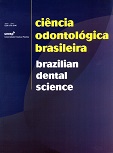Autopercepção das condições de saúde bucal de idosos do município de Araraquara – SP
DOI:
https://doi.org/10.14295/bds.2007.v10i3.290Abstract
O objetivo deste estudo foi verificar a saúde bucal e a autopercepção de 61 idosos atendidos na FOAR/UNESP, no ano de 2001. Para avaliação da autopercepção utilizou-se o Geriatric Oral Health Assessment Index (GOHAI) e o questionário proposto por Silva & Castellanos Fernandes14 (2001) (S&CF). Um examinador realizou exame clínico e adotou-se (0) para ausência e (1) para presença de problemas periodontais ou cárie radicular e, quando da presença de próteses (0) para não funcionais e (1) para funcionais. Realizou-se análise descritiva das variáveis. Testou-se a reprodutibilidade da autopercepção pela estatística Kappa (ê). Os pacientes foram agrupados em autopercepção “ótima”, “regular” e “ruim” e a associação com doença periodontal, cárie radicular e uso de prótese foi realizada pelo teste de qui-quadrado ou teste exato de Fisher, com significância de 5%. A maioria dos idosos afirmou nunca ter sofrido limitações devido a seus dentes, gengivas ou próteses, entretanto, o Índice GOHAI global foi de 27,77, característico de uma autopercepção ruim. Observou-se que 56% dos idosos apresentaram doença periodontal, 38% cárie radicular e 92% dos idosos eram usuários de próteses não funcionais. Houve baixa concordância entre os diferentes métodos de avaliação (ê = 0,087) e associação não-significativa entre o índice GOHAI e doença periodontal (÷2=0,856; p=0,5133), cárie radicular (÷2=0,002; p=0,9636) e o uso de próteses (Exato de Fisher: p=0,3286). As condições de saúde bucal apresentaram-se insatisfatórias e a autopercepção mostrou-se ruim, com associação não-significativa com as variáveis clínicas doença periodontal, cárie radicular e uso de prótese.
Downloads
Downloads
Published
How to Cite
Issue
Section
License
Brazilian Dental Science uses the Creative Commons (CC-BY 4.0) license, thus preserving the integrity of articles in an open access environment. The journal allows the author to retain publishing rights without restrictions.
=================




























